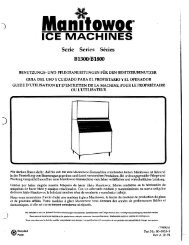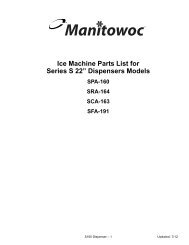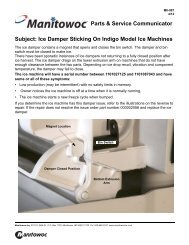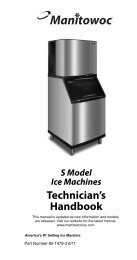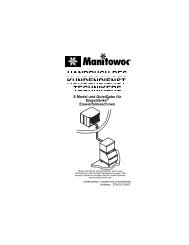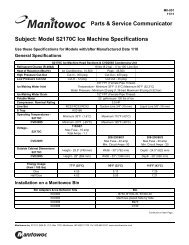S1800 Marine Model Ice Machines – Service Manual - Manitowoc Ice
S1800 Marine Model Ice Machines – Service Manual - Manitowoc Ice
S1800 Marine Model Ice Machines – Service Manual - Manitowoc Ice
You also want an ePaper? Increase the reach of your titles
YUMPU automatically turns print PDFs into web optimized ePapers that Google loves.
Section 7 Refrigeration System<br />
HARVEST VALVE TEMPERATURE CHECK<br />
General<br />
NOTE: This procedure requires checking both harvest<br />
valves.<br />
A harvest valve requires a critical orifice size. This<br />
meters the amount of hot gas flowing into the evaporator<br />
during the harvest cycle. If the orifice is even slightly too<br />
large or too small, long harvest cycles will result.<br />
A too-large orifice causes refrigerant to condense to<br />
liquid in the evaporator during the harvest cycle. This<br />
liquid will cause compressor damage. A too-small orifice<br />
does not allow enough hot gas into the evaporator. This<br />
causes low suction pressure, and insufficient heat for a<br />
harvest cycle.<br />
Refer to the Parts <strong>Manual</strong> for proper valve application. If<br />
replacement is necessary, Use only “original” <strong>Manitowoc</strong><br />
replacement parts.<br />
Harvest Valve Analysis<br />
Symptoms of a harvest valve remaining partially open<br />
during the freeze cycle can be similar to symptoms of<br />
either an expansion valve or compressor problem. The<br />
best way to diagnose a harvest valve is by using<br />
<strong>Manitowoc</strong>’s <strong>Ice</strong> Machine Refrigeration System<br />
Operational Analysis Table.<br />
Use the following procedure and table to help determine<br />
if a harvest valve is remaining partially open during the<br />
freeze cycle.<br />
1. Wait five minutes into the freeze cycle.<br />
2. Feel the inlet of the harvest valve(s).<br />
Important<br />
Feeling the harvest valve outlet or across the<br />
harvest valve itself will not work for this comparison.<br />
The harvest valve outlet is on the suction side (cool<br />
refrigerant). It may be cool enough to touch even if<br />
the valve is leaking.<br />
3. Feel the compressor discharge line.<br />
! Warning<br />
The inlet of the harvest valve and the compressor<br />
discharge line could be hot enough to burn your<br />
hand. Just touch them momentarily.<br />
4. Compare the temperature of the inlet of the harvest<br />
valves to the temperature of the compressor<br />
discharge line.<br />
Findings Comments<br />
The inlet of the<br />
harvest valve is cool<br />
enough to touch and<br />
the compressor<br />
discharge line is hot.<br />
The inlet of the<br />
harvest valve is hot<br />
and approaches the<br />
temperature of a hot<br />
compressor<br />
discharge line.<br />
Both the inlet of the<br />
harvest valve and<br />
the compressor<br />
discharge line are<br />
cool enough to<br />
touch.<br />
This is normal as the discharge line<br />
should always be too hot to touch and<br />
the harvest valve inlet, although too<br />
hot to touch during harvest, should be<br />
cool enough to touch after 5 minutes<br />
into the freeze cycle.<br />
This is an indication something is<br />
wrong, as the harvest valve inlet did<br />
not cool down during the freeze cycle.<br />
If the compressor dome is also entirely<br />
hot, the problem is not a harvest valve<br />
leaking, but rather something causing<br />
the compressor (and the entire ice<br />
machine) to get hot.<br />
This is an indication something is<br />
wrong, causing the compressor<br />
discharge line to be cool to the touch.<br />
This is not caused by a harvest valve<br />
leaking.<br />
Part Number 80-1634-3 7-15





